A woman’s gift (Click on the sermon title for a .pdf copy)
John 12:1-8
March 13, 2016
She made a gift to Jesus. Mary made a gift to Jesus, an extravagant gift. She took a whole pint of perfume, pure nard, and poured it out over Jesus’ feet. According to Judas, the perfume was worth about three hundred silver coins. Since one silver coin represented a day’s pay for a farm laborer, the value of the perfume was more than a year’s wages for a laborer working six days a week, or, in our money, about $18,000.
Eighteen thousand dollars! It was an enormously extravagant gift, over the top, wholly impractical, profligate, but she gave it. Because?
Why did I give Lynne an opal ring, an extravagant, wholly impractical gift, for our ninth wedding anniversary? Why did she promise me the kayak of my dreams, a lavish, over the top gift, for my birthday two years ago? Because of love, uncalculated, unrestrained, guilelessly generous love.
And so it was for Mary. She took the whole jar — Why did she have it? Where did she get it? Did she buy it just for this occasion or had she been saving it for some other purpose? — she took the whole jar and poured it out, all of it, because he mattered that much. It was not just the perfume she was giving him, but her heart, all of it.
She poured it out on his feet, approaching him humbly, like a servant. Her gesture was both astonishingly bold — she, a woman, touching a man in public, in that culture? — and unmistakably meek.
She poured out the whole jar and the sweet, spicy scent filled the house and she spread the oil over his feet with her hair. Her gift was anything but subtle; she had to have riveted the attention of every guest in the house. But it was also entirely unself-conscious, not to make a show, but just for him, a gift of love for him.
But Judas objected. “Why wasn’t the perfume sold and the money given to the poor?” At worst, he was being self-serving, but nobody can put the perfume back in the jar. At best, he was being earnest and practical, thinking of Jesus’ mission, the mission they had all made their own, caring for God’s precious children, especially those left behind or left out.
And Jesus’ answer? “Leave her alone!” Leave her alone. Let her make her gift. It is appropriate. It is appreciated. It is timely.
He understood it as a foreshadowing of the anointing of his body with spices and perfumes to dress it for burial, something other women would be preparing to do just a week hence. Do you think Mary understood it that way? Do you think she recognized, too, that she had little time left with him, that once he traveled the few miles into the city, into Jerusalem, his days were numbered, and she didn’t want to lose this last opportunity to show him, for his sake, for her sake, how precious he was to her?
“You will always have the poor with you,” Jesus said, “but you will not always have me.” What did he say? What did he say? Listen! Listen carefully, because almost nothing else Jesus ever said has been so misquoted and so misused.
It has been used to downplay the tragedy of economic inequality. “Yes, there are poor people in this world, lots of them, some through no fault of their own, but many by reason of their lack of ambition and willingness to work, but it’s just the way things are. After all, Jesus himself said, ‘You will always have poor people among you.’”
It has been used to excuse neglect and indifference. “Sure, I care, but nothing I can do, nothing we can do, will ever be able to end poverty anyway. You know that Jesus himself said, ‘You will always have poor people among you.’”
And it has been used — by people who should know better! — to discredit followers of Jesus who do care, who do make serving the poor a priority.
Did Jesus come to solve poverty? That depends. Poverty of possessions? No. Poverty of spirit? Yes …
I’m sure you’ve noticed that Jesus came into a world that was dominated by an oppressive government, saturated with slavery, and disadvantaged economically for much of the population. Yet, He did not seek to alter man’s political, social or economic status. Why not? Simply put, the externals in life will never change much … Jesus told the truth when He noted, “the poor you have with you always.” (Don Truex, “Did Jesus Come to Solve Poverty?”)
Shame on you! Shame! Jesus was not making a social commentary. Jesus was defending her gift, her outlandishly extravagant gift, her heartfelt gift of love. “She only has this moment to make her gift. You only have this moment to make your gift, but you will have time, you will have many opportunities, to make outlandishly extravagant gifts, heartfelt gifts of love to the poor, because, after I am gone, the poor will be with you still.”
And that’s what serving the poor should be: not a calculated, carefully measured duty, but an act of love, of unrestrained, uninhibited, profligate love. Like Mary’s gift, the gift she made to Jesus.
She made a gift to Jesus. María made a gift to Jesus, an extravagant gift. And she even has the same name! María, Mary … María Cristina Gómez.
María was born in 1938 in El Salvador and her life was her gift to Jesus. The Christ We Share image for this Sunday is a photograph of a Salvadoran cross painted in her honor. I keep a reproduction of the cross in my office.
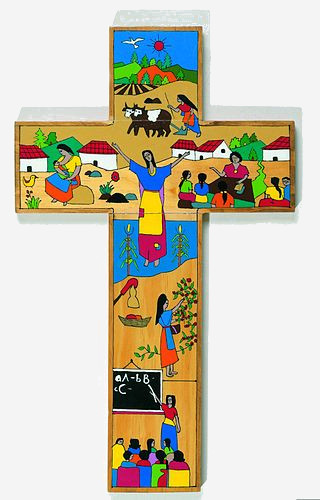 This was her life …
This was her life …
… teaching elementary school children
… harvesting fruits and vegetables
… traveling to rural villages to teach poor women to read so they in turn could teach their own children
… working hard, working the land
… nurturing a baby; along with her husband, she raised four children
This was her life: mother, teacher, advocate, friend, lover of Jesus.
She was a member of a Baptist church in San Salvador and the founder of the National Coalition of Salvadoran Women, an organization addressing issues of special concern to women, and of poor women in particular: rape, domestic violence, economic and social inequality, political exclusion.
This was her life, a most generous gift to the people of El Salvador, and a most generous gift to Jesus.
And for her gift, she was killed. Just before noon on April 5, 1989, as María Cristina was walking away from her school building after morning classes, a Jeep Cherokee with polarized windows pulled up alongside her and two armed men pushed her inside the car. An hour later, her body, covered with bruises and acid burns and riddled by four bullets, was dumped from the car onto a roadside. Her killers have never been apprehended, but suspicion and evidence implicates the El Salvadoran Air Force in the murder.
Why? The fact that she was dumped and not “disappeared” shows that this was meant as a warning, a warning to all the would-be Marías to back off: back off teaching poor women to read, back off educating poor women about their rights, back off giving poor women the tools to make something of themselves, to make a nuisance of themselves. She made a gift of her life, and the painted wooden cross, the María Cristina Gómez Cross, was commissioned by her church in her honor after her death.
You remember the other images in our Lenten series: the Korean Jesus bearing the weight of the cross and of the divided land …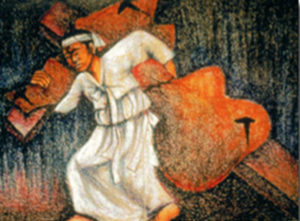
Jesus, the fierce Masai warrior who has gone to battle with our greatest enemies and won …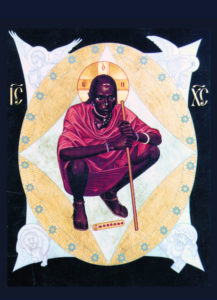
the dancing Balinese Jesus coming to us bringing light, bringing life, casting aside our demons, getting us moving, getting us dancing …
the tender Jesus, drawing us close in an intimate embrace …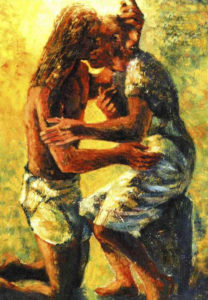
Jesus, the Filipino farmer, sharing a feast with his friends, one of them, one of us, welcoming us home …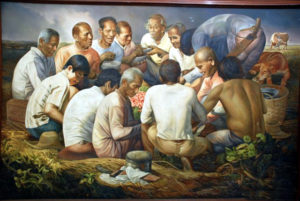
This image is different from the rest because it is the first image in the series that does not show Jesus.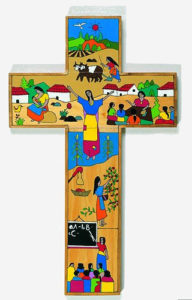
Or does it? You see María Cristina at the center of the cross with outstretched arms. Crucified too like Jesus? Crucified too with Jesus? Does the artist mean to say she embodies Jesus?
And yet, her arms are raised, in praise, in joy. She is smiling. In all the scenes painted on the cross, she is smiling. All the colors are bold and bright, primary colors, colors full of joy and energy and life.
I think the artist means to say that Jesus’ life and death give meaning, lasting meaning, to María’s life and work. Because he died, she lives even though she has died! Because Jesus died and was raised, she will be raised and her love endures, her work goes on.
I don’t think she is meant to be Jesus, but I do think Jesus is portrayed on this painted cross. Do you see him? Jesus is the schoolgirl. Jesus is the mother learning to read. Jesus is the tiny baby. “Whenever you did this for one of the least, you did it for me.”
María Cristina made a gift of herself … to Jesus. And whenever we serve the needs of the poor, whenever we give ourselves to each other and to the poor, we make a gift of love … to Jesus.
